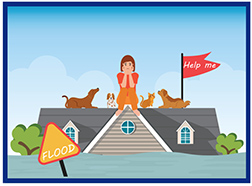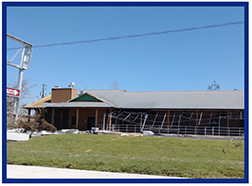SPECIAL FEATURE
Pet Disaster Preparedness
 For many of us, our pets are as much a part of our family as any person. They entertain, love us unconditionally, and are trustworthy confidantes. In good times and bad, they're there for us. For many of us, our pets are as much a part of our family as any person. They entertain, love us unconditionally, and are trustworthy confidantes. In good times and bad, they're there for us.
Sadly, when disasters strike, we are often caught off-guard when it comes to our pets. To help your clients be prepared, here is a quick guide to creating a pet emergency plan. Feel free to share this information with them in person or via email.
Ensure a Safe Place
If it's not safe for you to stay home, it's not safe for your pets. If a disaster strikes, know what evacuation routes to take and be aware of pet friendly places along the way . Be sure to call ahead, as some places will waive pet restrictions during a disaster.
If you have to seek refuge in an emergency shelter, be aware that generally only service animals are allowed. You may be able to shelter your animal with veterinarians, animal hospitals, and pet boarding facilities.
Keep a copy of your pet's medical records in your emergency preparedness kit, as most facilities will not board animals without this information.
Be aware that animal behavior can change dramatically during disasters. Having a plan for sheltering your pet will help to reduce the amount of stress both you and your pets are under.
In Case You're Separated
Anything can happen during a disaster including being separated from your pet.
It's important to keep recent photos of you with your pet in your emergency kit. If possible, look into having your animal microchipped and be sure to keep your contact information up to date in the system.
It's critical to remember to never leave animals tied/caged indoors or outdoors during a disaster. This can mean the difference between life or death of your pets.
Prepare a Disaster Kit
Just as you should have a disaster kit prepared for you and your family, you should also have one for your pets. When you're putting this kit together, keep these items in mind:
-
Five days' worth of pet food and water - Be sure to include bowls and a manual can opener if your pet eats canned food.
-
Medicines and medical records - Keep these in a waterproof container.
-
Leashes, harnesses and carriers - These items prevent pets from running away under stress.
-
Litter box/pooper scooper and plastic bags - Just in case.
-
Current photo of you with your pet - This will help anyone who finds your animal identify you as its owner.
-
A written copy of important things to know - Things such as your pet's feeding schedule, medical conditions and any behavioral issues in case you have to board your pet. Learn how to prepare your pets for an emergency evacuation and help them recover afterward.
In an emergency, your pets will be even more dependent on you for their safety and well-being. Your family's disaster plans must include your furry family members too. Learn what to do to keep your beloved pets safe!
Thank you to our Big "I" Flood program partner Selective for sharing these tips. Learn more about the Big "I" Flood program at www.iiaba.net/Flood.
|
Protect Businesses Against Hurricane Damage
 Hurricane damage poses a major threat for everyone in a storm's path, but for small business owners, a hurricane can spell destruction. As of April 2019, there have been two weather and climate events that had losses exceeding 1 billion dollars each. Many business owners can't afford to rebuild and reinvest after their business is destroyed, leading to a high likelihood of permanent closure. Hurricane damage poses a major threat for everyone in a storm's path, but for small business owners, a hurricane can spell destruction. As of April 2019, there have been two weather and climate events that had losses exceeding 1 billion dollars each. Many business owners can't afford to rebuild and reinvest after their business is destroyed, leading to a high likelihood of permanent closure.
Here's how business owners can prepare for the threat of a hurricane:
Understand Your Risk Profile
Hurricanes pose the greatest threat in the southern half of the Atlantic coast, as well as the Gulf coast region. Businesses further north along the coast and into the northeast and Midwestern states need to be aware that they can also be impacted by storm damage and flooding from a hurricane as it moves inland.
Having your risk assessed by an insurance professional can be beneficial in ensuring that you have the proper insurance coverage for your business.
Fortify Your Business
As a business owner, it's easy to believe that you will not be impacted by a hurricane. In reality, weather damage can strike anyone at any time. Now is the time to ensure that your business property is protected.
Business fortification goes beyond physical risk management. For companies in flood zones other than B, C or X, take time to find out if your community participates in the National Flood Insurance Program, a federal safeguard that provides affordable access to flood insurance for homes and businesses in vulnerable areas. Flood insurance is a great way to protect your business in the event of a hurricane. Selective offers flood insurance for business and personal property and contents.
Assemble a Contingency Plan
To keep your business alive in the event of a hurricane, you'll need to build a business continuity plan. A few important items to include in your continuity plan:
-
Copying and protecting important documents like business contracts, legal papers and the lease or deed for the land on which the business is located. When a hurricane threatens your equipment and other capital, you'll need to have key documents available offsite.
Instructing employees on their roles in the event of a hurricane, including response protocol. If your business is destroyed by a hurricane, you'll need to have a plan in place with a designated location to continue your operations as fast as possible to avoid additional profit loss.
Prepare and Protect Your Property
Preparing your property is also essential to protecting your business from hurricane damage.
Here are a few tips from the National Hurricane Survival Initiative:
-
Hire a professional roofer to determine if your company's roof needs to be reinforced or replaced.
-
Consider installing features around the windows so storm shutters can be used when the need arises.
-
Clear out a space to move valuable gear and equipment when a hurricane threatens.
-
Evaluate your exterior property and trim any trees and/or branches that could become flying projectiles.
-
Prepare a contact list so all employees can be made aware of violent weather.
-
Invest in an electric generator and learn how to use it, making sure the one you purchase is for commercial use.
-
Fill canisters and storage containers with gasoline to fuel power equipment if the electricity goes out.
-
Develop an emergency kit which has at least 72 hours' worth of water, non-perishable food, first-aid supplies and batteries for flashlights and radio equipment. Additional items to include can be found here.
Check out the National Hurricane Survival Initiative's website for additional ways to ready your property for hurricane season.
In addition, we encourage Big "I" Markets agents to follow our endorsed partner Selective on social media to stay up-to-date on information related to flood.
Take a moment now to:
Follow Selective on Facebook
https://www.facebook.com/Selective/
Follow Selective on Twitter
https://twitter.com/Selective
Follow Selective on LinkedIn
https://www.linkedin.com/company/selective-insurance
You can visit Selective online at selective.com. Learn more about the Big "I" Flood program at www.iiaba.net/Flood.
|
|
VU Webinars and Lightning Learning
Virtual University
|
WEBINARS - Two-hours with CE in select states.
View the complete calendar, registration links and see what states have CE approval online. Registration includes live webinar, on-demand recording and a transcript.
LIGHTNING LEARNING - Twenty minutes each with a focus on Meeting Production Goal Requires More Work Than You Think
-
July 9 - 11:30 a.m. ET - Key Information Needed to Write Condos
-
July 16 - 11:30 a.m. ET - 7 Condominium Definitions You Must Understand
-
July 23 -11:30 a.m. ET - Who Insures Which Property?
Register once for the monthly Lightning Learning package and receive all sessions for one low price. Registration includes live presentations and on-demand recordings.
VU Webinar and Lightning Learning questions can be sent to VU staff. The 2019 calendar and all links are available here.
|
|
|
Be one of the first five with the correct answers and win a $5 gift card (Starbucks, Dunkin' Donuts, Baskin Robbins, or Krispy Kreme).
Congratulations to this week's winners - Rebecca Costa (NC), Julie Singley (AL), Linda Lyons (NC), Kathy King (MD), & Ed James (FL).
1. The oldest single tree in the world is around 5,000 years old. What type of tree is it? - GREAT BASIN BRISTLECONE PINE (Pinus Longaeva)
2. In the first Coalition article if you click on the "mitigation apps, tools" link under "Can your insurance company do this?" rolling list, which type of service comes after DDoS mitigation? - RANSOMWARE PROTECTION
3. Knob and tube wiring fell out of common use in the early 1940s, and today is only allowed in very few situations as outlined in the National Electric Code. These safety standards are published by which trade association? - NATIONAL FIRE PROTECTION ASSOCIATION
TIE BREAKER
TB - Coalition is headquartered in San Francisco. Today's population is nearly 900,000 residents. What event in 1848 led to a major population boom? - CALIFORNIA GOLD RUSH
|
BIG "I" MARKETS SALE OF THE WEEK
|
|
|
|
|
|
 |